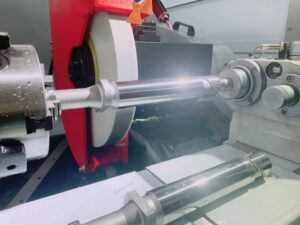What is Grinding? How it Works, Types, and Applications
2025-04-22
What is Grinding? How it Works, Types, and Applications

Grinding is a widely used manufacturing process essential for achieving fine surface finishes and precise dimensional tolerances. It is a key part of the machining industry, allowing for the production of components that require accuracy and smooth surfaces. From automotive parts to aerospace components, grinding plays a crucial role in ensuring the quality and functionality of a variety of materials.
In this post, we’ll dive deeper into what grinding is, how it works, and the different types of grinding processes used in manufacturing.
How Grinding Works
At its core, grinding is a material removal process that uses a rotating abrasive wheel to smooth or shape a workpiece. Unlike traditional cutting methods, grinding relies on the abrasive properties of the grinding wheel to remove material. The wheel is made of small, hard particles that grind against the surface of the workpiece, gradually removing fine layers of material.
As the wheel rotates, the abrasive particles on its surface interact with the workpiece, shearing off small amounts of material and leaving behind a finely finished surface. This process is particularly useful for achieving highly precise dimensions and surface finishes that cannot be accomplished with standard cutting tools.

A grinding machine typically consists of several key components:
- Grinding Wheel: The heart of the grinding machine, the grinding wheel is made of abrasive particles bonded together. It performs the actual cutting by removing material from the workpiece surface.
- Wheel Head: This component houses the grinding wheel and contains the mechanisms required to drive and control its rotation. It allows for accurate adjustment of the wheel’s position during operation.
- Table: The table supports the workpiece and provides controlled movement—either linear or rotary—depending on the machine type. Its precision movement is crucial for accurate grinding.
- Coolant System: This system delivers coolant fluid to the grinding area to dissipate heat, prevent thermal damage to the workpiece, and flush away swarf (metal particles) generated during grinding.
- Control Panel: The operator uses the control panel to manage various machine settings, including spindle speed, feed rate, and grinding depth. It ensures precision and repeatability in the grinding process.
- Dresser: The dresser is used to maintain the grinding wheel’s shape and surface sharpness. Regular dressing ensures consistent cutting performance and prolongs wheel life.
- Safety Guards: Installed around the grinding wheel and other critical areas, safety guards protect the operator from sparks, debris, and accidental contact with moving parts.
Applications and Importance of Grinding
Grinding is used across a wide range of industries where precision and smooth finishes are crucial. Some of the most common applications of grinding include:
- Automotive: For machining engine components, transmission parts, and gears with exacting tolerances.
- Aerospace: Precision grinding is used for parts like turbine blades, shafts, and other complex components where even minor imperfections can affect performance.
- Tool manufacturing: Grinding is used to sharpen cutting tools, such as drills, mills, and knives, ensuring they maintain their effectiveness and precision.
- Medical devices: In the medical field, grinding is used for components like implants and surgical tools, which require both high precision and smooth surfaces.
Grinding also plays a significant role in finishing processes. It is commonly used when parts are too hard or too delicate for conventional machining techniques, such as milling or turning. By utilizing grinding, manufacturers can achieve tolerances down to microns and surface finishes that are critical for the proper functioning of certain components.
Types of Grinding Processes
Grinding is not a one-size-fits-all process. Depending on the shape, material and requirements of the workpiece, there are several different types of grinding methods used. Below are some of the most common:
- Surface Grinding
This process is used to produce flat surfaces. The workpiece is held on a magnetic chuck or fixture, and the grinding wheel is moved across the surface to achieve a smooth, even finish. Surface grinding is often used to refine parts that require a precise flatness or smoothness, such as machine tool beds and precision components. - Cylindrical Grinding
Cylindrical grinding is used for grinding cylindrical or rounded workpieces. The workpiece is held between two centers or clamped in a chuck while the grinding wheel rotates around it. This method is commonly used to finish shafts, spindles, and other parts with circular shapes. The cylindrical grinding process can achieve excellent dimensional accuracy and surface finishes. - Centerless Grinding
In centerless grinding, the workpiece is supported by a regulating wheel and an abrasive grinding wheel, with no need for clamping the part in place. The workpiece is fed between the wheels, and the grinding process occurs as the part moves continuously along the wheel’s path. Centerless grinding is particularly useful for parts that are long, cylindrical, and require consistent diameters along their length. It is commonly used for parts like rods, bars, and bearings.
To read about more types of grinding, see Understanding Different Grinding Processes and Choosing the Right Method for Your Material
The Advantages of Grinding
Grinding offers several advantages over other machining methods, especially when dealing with hard materials or high-precision applications. Some of the key benefits include:
- High precision: Grinding allows for incredibly tight tolerances, making it ideal for applications where accuracy is critical.
- Smooth surface finish: The abrasive action of the grinding wheel creates a fine surface finish that is often superior to other machining methods.
- Material versatility: Grinding can be used on a wide range of materials, including hard metals, ceramics, and composites, which might be difficult to machine using traditional cutting methods.
- Complex shapes: Grinding can be used to produce intricate shapes, fine features, and sharp edges that might be difficult to achieve with other tools.
Conclusion
Grinding is an essential process in the world of precision manufacturing, allowing shops to create components that meet stringent specifications for accuracy, surface finish, and durability. Whether it’s surface grinding, cylindrical grinding, or centerless grinding, each method plays a unique role in ensuring the highest quality products.
With its ability to work with tough materials, achieve tight tolerances, and provide smooth finishes, grinding remains a fundamental process in industries like automotive, aerospace, and medical device manufacturing. Understanding the different types of grinding and their applications can help businesses choose the right approach for their specific needs, ensuring the production of high-quality, reliable components.


